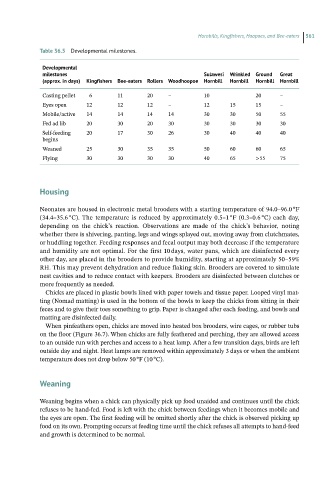Page 561 - Hand rearing birds second
P. 561
Hornbills, Kingfishers, Hoopoes, and Bee-eaters 561
Table 36.5 Developmental milestones.
Developmental
milestones Sulawesi Wrinkled Ground Great
(approx. in days) Kingfishers Bee-eaters Rollers Woodhoopoe Hornbill Hornbill Hornbill Hornbill
Casting pellet 6 11 20 – 10 20 –
Eyes open 12 12 12 – 12 15 15 –
Mobile/active 14 14 14 14 30 30 50 55
Fed ad lib 20 30 20 30 30 30 30 30
Self‐feeding 20 17 30 26 30 40 40 40
begins
Weaned 25 30 35 35 50 60 60 65
Flying 30 30 30 30 40 65 >55 75
Housing
Neonates are housed in electronic metal brooders with a starting temperature of 94.0–96.0 °F
(34.4–35.6 °C). The temperature is reduced by approximately 0.5–1 °F (0.3–0.6 °C) each day,
depending on the chick’s reaction. Observations are made of the chick’s behavior, noting
whether there is shivering, panting, legs and wings splayed out, moving away from clutchmates,
or huddling together. Feeding responses and fecal output may both decrease if the temperature
and humidity are not optimal. For the first 10 days, water pans, which are disinfected every
other day, are placed in the brooders to provide humidity, starting at approximately 50–59%
RH. This may prevent dehydration and reduce flaking skin. Brooders are covered to simulate
nest cavities and to reduce contact with keepers. Brooders are disinfected between clutches or
more frequently as needed.
Chicks are placed in plastic bowls lined with paper towels and tissue paper. Looped vinyl mat-
ting (Nomad matting) is used in the bottom of the bowls to keep the chicks from sitting in their
feces and to give their toes something to grip. Paper is changed after each feeding, and bowls and
matting are disinfected daily.
When pinfeathers open, chicks are moved into heated box brooders, wire cages, or rubber tubs
on the floor (Figure 36.7). When chicks are fully feathered and perching, they are allowed access
to an outside run with perches and access to a heat lamp. After a few transition days, birds are left
outside day and night. Heat lamps are removed within approximately 3 days or when the ambient
temperature does not drop below 50 °F (10 °C).
Weaning
Weaning begins when a chick can physically pick up food unaided and continues until the chick
refuses to be hand‐fed. Food is left with the chick between feedings when it becomes mobile and
the eyes are open. The first feeding will be omitted shortly after the chick is observed picking up
food on its own. Prompting occurs at feeding time until the chick refuses all attempts to hand‐feed
and growth is determined to be normal.

